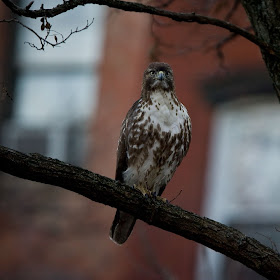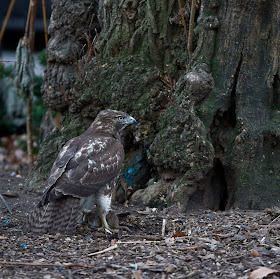
Photograph by Francois Portmann http://www.fotoportmann.com/
And from Francois Portmann--"Another great moment for the last day of the year at Tompkins Square Park."
F.
And indeed it is! Valkyrie is at it again!
Is that lump on the branch below her, an uncooperative squirrel? They do tend to bring out the sneaky walk in young Red-tails.

Photograph by Francois Portmann
Off to greener pastures...

Photograph by Francois Portmann
Carrion Goddess indeed!

Photograph by Francois Portmann

Photograph by Francois Portmann

Photograph by Francois Portmann
Zing! She's got something in her sights!

Photograph by Francois Portmann

Photograph by Francois Portmann
Previous to flying over to the fence, Valkyrie must have put on her invisibility suit. These pedestrians haven't noticed her at all.

Photograph by Francois Portmann

Photograph by Francois Portmann
She looks with definite focus and special interest.

Photograph by Francois Portmann
Eyes still latched onto whatever it is, she's up.

Photograph by Francois Portmann
She concentrates and flows into super stealth mode.

Photograph by Francois Portmann
She got it! See the rat under her? And that is no small rat. Look at the girth of its tail compared to Valkyrie's "ankles".

Photograph by Francois Portmann
And off she goes, for a very big dinner. She's really getting this hunting thing down. Though I am always a bit squeamish about the hawks eating rats due to the possible poisoning issue.
Speaking of which, look at the photo just above this one. See that aqua splotch. Francois asked if I thought it was paint or perhaps a more toxic substance. At first I thought probably paint, but then I began to look more carefully and wasn't sure about it being paint after all.
There looks to be a broken rectangular piece of aqua something stuck in the bark to the right of Valkyrie. Also note the scattered aqua pieces on the ground. Could just be bits of painted bark, I suppose. Though I have found rat poison scattered in that manner near rat refuges. Illegal but still done. Let's hope it's just paint. Francois is going to carefully check it out.

Photograph by Karen Anne Kolling
While New York City only got .03 inches of snow in the last bout, Rhode Island got more plus the bitter cold snap. It was so cold in fact that contributor Karen Anne Kollings bird bath heater couldn't keep up, though this dove must be finding some warmth or she wouldn't be standing there.
Karen also reports that she discovered three of her Mourning Doves, engaging in Doorstep's warming strategy--snuggling against the bottom of the sliding door to absorb the escaping heat from the house.

Photograph by Karen Anne Kolling
And here we get the perfect look as to why many animals have two layer system winter coats.
Here the longest layer catches the snow and keeps it away from the body heat which would melt it wetting the animal. The lower insulating layer stays dryer and therefore warmer. In fact I suppose it's possible that the more snow that builds up on the longer hair, the more it insulates the squirrel . Rather like a one's own personal igloo.
R. of Illinois contributes the kind of animal story we love to hear...
Moose rescued from Priest Lake
http://www.khq.com/global/story.asp?s=9606329
COOLIN, Idaho - A group of good Samaritans in North Idaho rescued a moose
that fell through the ice in front of Bishop's Marina on Priest Lake
Thursday. Witnesses say brave Coolin residents rallied and successfully got
the moose out of the freezing water and to the shoreline.
The moose was first spotted around 7 a.m. Rescuers on scene used ropes and a
long plank of wood as a lever to help free the moose from the ice. The
rescue lasted approximately six hours from the time the moose was spotted.
After getting the moose to shore, rescuers covered the animal with blankets,
including an electric blanket powered by 250 feet of extension cords.
Rescuers also used hay and a propane heater to warm the animal.
The moose finally stood up on its own around 4 p.m. And walked into the woods as the rescuers cheered it on.
Just when your optimism about people and animal interactions begins to fail you, here comes something that reinvigorates your belief in people!
I just keep thinking about the individual who ran around collecting 250 feet of extension cords for the electric blanket.
What if the cords were all only six feet long? That's forty some extensions. So here's a couple question. How many doors does one have to knock on to collect 40 extension cords. And who was the saint who donated her electric blanket so it could cover a half frozen moose?
Coolin's Moose rescuers deserve an extremely big gold star. Let's hope there was a watering hole at the Marina and they, everyone, got a drink on the house!
Donegal Browne
P.S. Don't miss Rob Schmunk's shot of Isolde with a very very stuffed crop, http://Bloomingdalevillage.blogspot.com




























